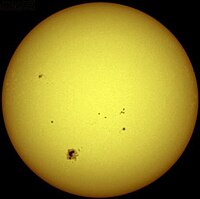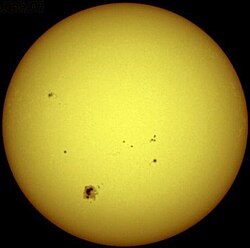Granuler

Granuler är små ljusare områden på solytan som orsakas av konvektioner, det vill säga värme som stiger upp från solens inre.[1]
En typisk granul är ungefär 1 500 km i diameter[2] och existerar i omkring 8–20 minuter innan den upplöses.[3]
Referenser
- ^ Dan Kiselman. ”Solen”. ne.se. Nationalencyklopedin. https://www.ne.se/uppslagsverk/encyklopedi/l%C3%A5ng/solen. Läst 3 december 2019.
- ^ Zirker, J. B. (2003) (på engelska). Sunquakes. Johns Hopkins University Press. sid. 2
- ^ Bahng, J.; Schwarzschild, M. (12 april 1961). ”Lifetime of Solar Granules” (på engelska). The Astrophysical Journal 134: sid. 312. doi:. http://articles.adsabs.harvard.edu/cgi-bin/nph-iarticle_query?1961ApJ...134..312B&defaultprint=YES&filetype=.pdf. Läst 3 november 2019.
| |||||||||||||||||||||||||||||||||||||||
Media som används på denna webbplats
Solen och några solfläckar. De två små fläckarna i mitten har ungefär samma diameter som jorden.
Granules are small (about 1000 km across) cellular features that cover the entire Sun except for those areas covered by sunspots. These features are the tops of convection cells where hot fluid rises up from the interior in the bright areas, spreads out across the surface, cools and then sinks inward along the dark lanes. Individual granules last for only about 20 minutes. The granulation pattern is continually evolving as old granules are pushed aside by newly emerging ones. The flow within the granules can reach supersonic speeds of more than 7 km/s (15,000 mph) and produce sonic "booms" and other noise that generates waves on the Sun's surface.
Granules-like structure of surface of sun and sunspots (size around 20'000km). Visible light. Taken by Hinode's Solar Optical Telescope (SOT). These sunspots belong to AR 10930 where X3.4 flare occurred on that day.




